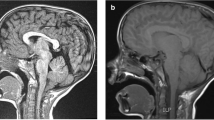Abstract
Introduction
Robinow syndrome is a rare entity with a characteristic appearance, such as hypertelorism, short stature, mesomelic shortening of the limbs, hypoplastic genitalia, and rib as well as vertebral anomalies. We had treated a patient with Robinow syndrome who developed hydrocephalus and craniosynostosis which is not usually associated.
Case presentation
The ventricle enlargement was detected during pregnancy in a female infant. She did not develop hydrocephalus just after birth. Her facial appearance was fetus-like, so the pediatricians had suspected Robinow syndrome. During follow-up examinations, a rapidly enlarging head circumference was detected when she was 3 months old. Her conscious level was not disturbed, but she had a tight fontanel and sunset phenomenon was recognized. Hydrocephalus was diagnosed by radiographic imaging so that she underwent ventriculo-peritoneal shunting (VPS). Her irregular head enlargement seized. Six months after surgery, her parents noticed the brachycephalic shape of her head. A computed tomography (CT) and magnetic resonance (MR) scan were conducted and showed that her bilateral coronal, bilateral lambdoid, and the sagittal suture were fused in addition with a tonsillar herniation. Since the sutures were not remaining, we diagnosed that this was a primary pan synostosis rather than secondary craniosynostosis due to VPS. Posterior cranial vault distraction with foramen magnum decompression (FMD) was conducted. The distractor was extended by 1 mm per day up to 30 mm. After a consolidation period of 2 months, the distractors were removed. Through this intervention, a 15.4% increase (+196cc) of the intracranial space with an improvement of the chronic tonsillar herniation was achieved.
Conclusion
To confirm the diagnosis of Robinow syndrome, a genetic test was conducted. The analysis showed ROR2 Exon3 (c233 c>t p. Thr 78 Met), which is found in the recessive type of Robinow syndrome. We report this patient as, to our best knowledge, the first case documented case of Robinow disease presenting with hydrocephalus and craniosynostosis. Posterior cranial vault distraction with FMD is a useful way to treat this condition.




Similar content being viewed by others
References
Mazzeu JF, Pardono E, Vianna-Morgante AM, Richieri-Costa A, Ae Kim C, Brunoni D, Martelli L, de Andrade CE, Colin G, Otto PA (2007) Clinical characterization of autosomal dominant and recessive variants of Robinow syndrome. Am J Med Genet A 143:320–325
Robinow M, Springs Y, Silverman FN, Smith HD (1969) A newly recognized dwarfing syndrome. Am J Dis Child 117:645–651
Patton MA, Afzal AR (2002) Robinow syndrome. Journal of Medical Genetics 39:305–310
Thomale UW, Gebert AF, Haberl H, Schulz M (2013) Shunt survival rates by using the adjustable differential pressure valve combined with a gravitational unit (proGAV) in pediatric neurosurgery. Childs Nerv Syst 29:425–431
Roifman M, Marcelis CL, Paton T, Marshall C, Silver R, Lohr JL, Yntema HG, Venselaar H, Kayserili H, van Bon B, Seaward G, Consortium FC, Brunner HG, Chitayat D (2015) De novo WNT5A-associated autosomal dominant Robinow syndrome suggests specificity of genotype and phenotype. Clin Genet 87:34–41
Afzal AR, Jeffery S (2003) One gene, two phenotypes: ROR2 mutations in autosomal recessive Robinow syndrome and autosomal dominant brachydactyly type B. Hum Mutat 22:1–11
van Bokhoven H, Celli J, Kayserili H, van Beusekom E, Balci S, Brussel W, Skovby F, Kerr B, Percin EF, Akarsu N, Brunner HG (2000) Mutation of the gene encoding the ROR2 tyrosine kinase causes autosomal recessive Robinow syndrome. Nat Genet 25(4):423–426
White JJ, Mazzeu JF, Coban-Akdemir Z, Bayram Y, Bahrambeigi V, Hoischen A, van Bon BWM, Gezdirici A, Gulec EY, Ramond F, Touraine R, Thevenon J, Shinawi M, Beaver E, Heeley J, Hoover-Fong J, Durmaz CD, Karabulut HG, Marzioglu-Ozdemir E, Cayir A, Duz MB, Seven M, Price S, Ferreira BM, Vianna-Morgante AM, Ellard S, Parrish A, Stals K, Flores-Daboub J, Jhangiani SN, Gibbs RA, Baylor-Hopkins Center for Mendelian G, Brunner HG, Sutton VR, Lupski JR, Carvalho CMB (2018) WNT signaling perturbations underlie the genetic heterogeneity of Robinow syndrome. Am J Hum Genet 102:27–43
Cerqueira DF, de Souza IP (2008) Orofacial manifestations of Robinow's syndrome: a case report in a pediatric patient. Oral Surg Oral Med Oral Pathol Oral Radiol Endod 105:353–357
Beiraghi S, Leon-Salazar V, Larson BE, John MT, Cunningham ML, Petryk A, Lohr JL (2011) Craniofacial and intraoral phenotype of Robinow syndrome forms. Clin Genet 80:15–24
Golinko MS, Atwood DN, Ocal E (2018) Surgical management of craniosynostosis in the setting of a ventricular shunt: a case series and treatment algorithm. Childs Nerv Syst 34:517–525
Komuro Y, Yanai A, Hayashi A (2004) Treatment of unilateral lambdoid synostosis with cranial distraction. J Craniofac Surg 15:609–613
White N, Evans M, Dover MS, Noons P, Solanki G, Nishikawa H (2009) Posterior calvarial vault expansion using distraction osteogenesis. Childs Nerv Syst 25:231–236
Komuro Y, Shimizu A, Ueda A, Miyajima M, Nakanishi H, Arai H (2011) Whole cranial vault expansion by continual occipital and fronto-orbital distraction in syndromic craniosynostosis. J Craniofac Surg 22:269–272
Komuro Y, Shimizu A, Shimoji K, Miyajima M, Arai H (2015) Posterior cranial vault distraction osteogenesis with barrel stave osteotomy in the treatment of craniosynostosis. Neurol Med Chir (Tokyo) 55:617–623
Senda D, Orgun D, Shimizu A, Shimoji K, Miyajima M, Arai H, Mizuno H, Komuro Y (2019) Quantitative analysis of change in intracranial volume after posterior cranial vault distraction and frontal orbital advancement/remodeling. J Craniofac Surg 30:23–27
Author information
Authors and Affiliations
Corresponding author
Ethics declarations
Conflict of interest
The authors have no conflicts of interest related to the paper herein discussed.
Additional information
Publisher’s note
Springer Nature remains neutral with regard to jurisdictional claims in published maps and institutional affiliations.
Rights and permissions
About this article
Cite this article
Sakamoto, K., Senda, D., von Däniken, S. et al. Robinow syndrome in a newborn presenting with hydrocephalus and craniosynostosis. Childs Nerv Syst 37, 3235–3239 (2021). https://doi.org/10.1007/s00381-021-05087-x
Received:
Accepted:
Published:
Issue Date:
DOI: https://doi.org/10.1007/s00381-021-05087-x




